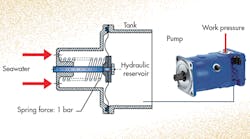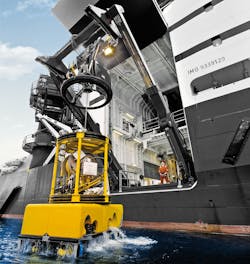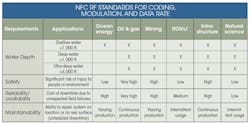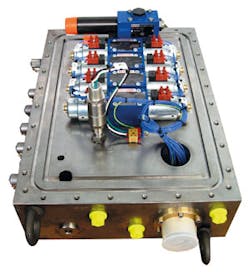More than two-thirds of the earth’s surface is covered by water, and many potential resources in those depths await exploration and development. Industries involved in this new frontier include mining, oil and gas, infrastructure, energy generation, and natural science.
These activities all involve complex and highly technical systems. Many of them—particularly those performed beneath the sea’s surface—use a broad array of electrohydraulic systems to lower and lift equipment to the seabed, remote-operate subsea systems, and permanently monitor emplaced systems (e.g., petroleum wellheads or communications cables).
This file type includes high resolution graphics and schematics when applicable.
Such hydraulic equipment often is assumed to be specifically designed and engineered using special materials for operation under the high pressures and corrosive conditions of different sea depths. However, with sufficient customization, many standard hydraulic systems designed for surface use can operate effectively in this demanding environment.
Ultimately, the operation of any hydraulic system requires isolating the hydraulic circuit from external environments and controlling the fluid to perform work. The principles are the same; therefore, the design principles for subsea simply call for considering additional conditions.
Comparison of Subsea Requirements
Selecting the best solution for a given application requires understanding how the different subsea water depths impact the hydraulic system. The analyses used in oil and gas exploration supply an effective set of guidelines.
At depths to 1,000 ft. (305 m), components must operate in salt water, but not in significantly high water pressures. The equipment is relatively easy to operate, put in place, and retrieve. However, sunlight may penetrate up to 200 m, thus promoting the growth of sea life over the equipment surface. This must be factored into designs of components such as piston rods in hydraulic cylinders.
In depths from 1,000 to 6,000 ft. (305 to 1,830 m), hydrostatic pressure becomes a major concern. Water pressure increases about 1 bar (14.5 psi) for every 10 m of depth. Consequently, at 5,000 m (16,400 ft), the ambient pressure will be 500 bar (7,250 psi). At these depths, all work is done with remote-control systems and subsea robots, such as remote operated vehicles (ROVs) and autonomous underwater vehicles (AUVs).
Components exposed to these high external water pressures may require special design features, such as pressure compensation or structural modifications. These depths are typically encountered far from shore, requiring floating platforms or ships and platforms, which create additional challenges.
Aside from military and research vessels, there’s little experience with subsea equipment in ultra-deep water—from 6,000 to 35,800 ft. (1,830 to 10,900 m). As depths increase, even the engineering of hoisting and tether equipment construction must change to accommodate the dimensions and weight of the systems as they increase with the water depth. Furthermore, the ocean conditions become harsher, such as the size of waves or the forces caused by maritime currents.
Robotics: The Subsea Enabler
Because divers cannot operate beyond a depth of 100 m, the bulk of subsea activities must be performed by ROVs and AUVs, complex systems that use extensive electromechanical and electrohydraulic subsystems to accomplish tasks. Though their operational depths can be in any range, robots typically aren’t submerged for long periods of time. However, it’s critical they are ready when needed, and if they malfunction, the downtime must be kept to a minimum.
The advantages of hydraulic drives really come to light in these machines: They are powerful, compact, precise, intelligent, and rugged, providing excellent power density and adroit flexibility for a wide range of tasks. That said, ROV and AUV developers continue to seek more sophisticated performance and reliability from these integrated electrohydraulic systems.
Subsea Design Requirements
Successful growth of many subsea applications depends on how long equipment can be reliably and safely deployed and operated without requiring overly expensive engineering, operating, and repair costs. Some built-in costs for subsea work are unavoidable—operating equipment at a distance with remote devices, and dealing with external water pressure, currents, and corrosion conditions. Careful planning and a willingness to integrate smart design principles into subsea hydraulic systems make it possible to cost-effectively accomplish these goals.
Pressure compensation is useful in any system that operates underwater. It’s used to keep the pressure between external environment (seawater) and reservoir constant, because seals are typically designed for a limited pressure drop in one particular direction. Most components readily available were designed for operation in normal surface environments. Almost all machines have sealing surfaces or other parts that cannot withstand high subsea external pressures or severe pressure drops.
Although complicated and expensive, one option is to seal pressure-sensitive components inside a protective chamber. This usually involves a container with rigid construction and heavy-duty seals to withstand the high external pressures. A more effective solution, however, is pressure compensation. With this technique, a pressure is applied inside the component that’s equal and opposite to the ambient pressure outside.
In a typical hydraulic system, the standard reservoir is replaced with a sealed reservoir containing a flexible medium separator. Therefore, the external environment pressure transfers to the reservoir, just as a normal surface system has the external air pressure on top of the oil in the reservoir. The difference is that it prevents the seawater from mixing with the oil.
This clever system allows any component used on the surface to be used subsea, as long as all volumes that normally contain air can be vacated of air filled with fluid and connected to the reservoir to maintain the pressure balance.
Corrosion Protection and Sealing
Offshore machines typically have a seal, sealing surface, seawater, and some other medium in contact and interacting with each other. The study of these items is known as tribology. Knowledge of this is critical for system designers, to both keep seawater out of a system and keep the hydraulic fluid in. On large hydraulic cylinders, for example, maintaining the integrity of the piston rod, which is routinely exposed to environmental conditions in operation, is essential for maintaining long-term operating life of the system.
No matter what the application, though, hydraulic-cylinder design always involves an interaction between seals, fluid, and material surface. The cylinder’s piston rod surface needs an appropriate coating to provide a good and durable base for its tribological system. Major advances have occurred in cylinder coating technologies, including metallic/metal mix systems applied with high velocity oxygen fuel (HVOF) or cobalt-alloy coatings applied via plasma arc welding.
Designing for Safety and Reliability
Equipment engineered for subsea applications must protect both people and the ocean environment from any damage. For deep water and ultra-deep water operations, surface operators need protection from equipment failures during the whole lifecycle of the subsea system.
Subsea operations are carried out in environmentally sensitive areas. Most hydraulic systems must adhere to specific safety standards, such as fail-safe operation. Therefore, if the power supply is cut off, this de-energization principle causes the hydraulic system to automatically shift to a safe position. These principles of risk assessment and functional safety have been established through international standards such as ISO 12100, ISO 13849, and ISO 4413.
The reliability of subsea equipment with a projected 30-year lifetime, operating in such a harsh environment, represents one of the biggest challenges for the industry today. Reliable hydraulic-system design for subsea applications can apply different approaches at the same time:
• Use highly reliable components. A reliability indicator should be used to compare parameters like mean time to failure, B10 life, or Weibull distributions.
• Cost-effective redundant architecture can be installed for higher system reliability. In some cases, more than two components may be needed to support each other.
• Integration of failure diagnostic features, such as suitable sensors and algorithms to process their information, can detect a failure and decide the appropriate corrective reaction.
Field operators in oil and gas applications expect minimal maintenance from subsea equipment during a well location’s entire service life, which can be 30 years or more. Suitable sensors must be designed, integrated and pressure-proven to detect failures and, if possible, anticipate future failures by including condition monitoring functions.
As industries move deeper into the ocean, fundamental technical challenges increase, particularly for hydraulically driven systems. These challenges can be met through a combination of standard, off-the-shelf components proven to operate in rugged conditions on the land, with suitable adaptations and smart, cost-effective application of more advanced materials where needed. This approach can ultimately deliver more cost-effective subsea development and wider access to the potential resources offered by this emerging frontier.
This file type includes high resolution graphics and schematics when applicable.
Royce Gerngross is Engineer, Marine & Offshore, and Alexandre Orth, PhD, is Project Risk Manager at Bosch Rexroth AG., Lohr, Germany.







